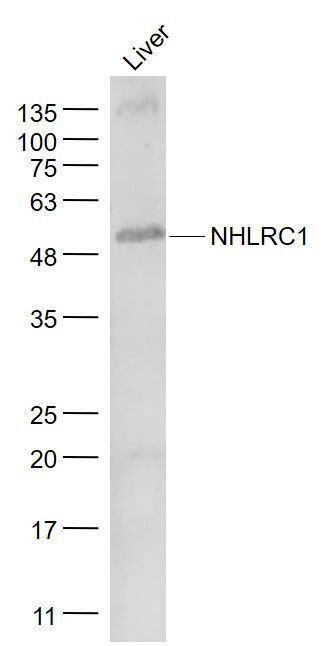产品货号 : mlR9331
英文名称 : NHLRC1
中文名称 : 肌痉挛性癫痫病相关EPM2A蛋白抗体
别 名 : E3 ubiquitin-protein ligase NHLRC1; EPM2A; EPM2B; Malin; MGC119262; MGC119264; NHL repeat containing 1; NHL repeat containing protein 1; NHL repeat-containing protein 1; NHLC1_HUMAN; NHLRC 1; Nhlrc1.
研究领域 : 心血管 细胞生物 免疫学 神经生物学
抗体来源 : Rabbit
克隆类型 : Polyclonal
交叉反应 : Human, Mouse, Rat, Rabbit,
产品应用 : WB=1:500-2000 ELISA=1:500-1000 IHC-F=1:400-800 IF=1:50-200 (石蜡切片需做抗原修复)
not yet tested in other applications.
optimal dilutions/concentrations should be determined by the end user.
分 子 量 : 42kDa
细胞定位 : 细胞核 细胞浆
性 状 : Lyophilized or Liquid
浓 度 : 1mg/ml
免 疫 原 : KLH conjugated synthetic peptide derived from human NHLRC1:221-320/395
亚 型 : IgG
纯化方法 : affinity purified by Protein A
储 存 液 : 0.01M TBS(pH7.4) with 1% BSA, 0.03% Proclin300 and 50% Glycerol.
保存条件 : Store at -20 °C for one year. Avoid repeated freeze/thaw cycles. The lyophilized antibody is stable at room temperature for at least one month and for greater than a year when kept at -20°C. When reconstituted in sterile pH 7.4 0.01M PBS or diluent of antibody the antibody is stable for at least two weeks at 2-4 °C.
PubMed : PubMed
产品介绍 : Progressive myoclonic epilepsy type 2 (EPM2), also called Lafora disease, is an autosomal recessive disease characterized by grand mal seizures and/or myoclonus at about 15 years of age. Rapid and severe mental deterioration follows, often with psychotic features. Survival is less than 10 years after onset. Starch-like, endoplasmic reticulum-associated polyglucosans, called Lafora bodies, can be observed in brain, muscle, liver and heart. One cause of Lafora disease is due to mutations in NHLRC1, the gene encoding Malin. Forty-nine different mutations in NHLRC1 have been shown to cause EPM2. Malin, also called NHL repeat-containing protein 1, is a single subunit E3 ubiquitin ligase, containing 6 NHL repeats and 1 RING-type zinc finger. Malin’s RING domain is responsible for its ability to mediate ubiquitination. Malin interacts with and polyubiquitinates Laforin, a protein also implicated in EPM2. Malin localizes to the endoplasmic reticulum and, to a lesser extent, in the nucleus. Malin is expressed in brain, cerebellum, spinal cord, medulla, heart, liver, skeletal muscle and pancreas.
Function:
E3 ubiquitin-protein ligase which in complex with EPM2A/laforin and HSP70 suppresses the cellular toxicity of misfolded proteins by promoting their degradation through the ubiquitin-proteasome system (UPS). Ubiquitinates PPP1R3C/PTG in a laforin-dependent manner, and targets it for proteasome-dependent degradation and this degradation decreases glycogen accumulation. Polyubiquitinates EPM2A/laforin and ubiquitinates AGL and targets them for proteasome-dependent degradation.
Subunit:
Interacts with AGL. Interacts (via the NHL repeats) with EPM2A/laforin. Forms a complex with EPM2A/laforin and HSP70.
Subcellular Location:
Endoplasmic reticulum. Nucleus. Localizes at the endoplasmic reticulum and, to a lesser extent, in the nucleus.
Tissue Specificity:
Expressed in brain, cerebellum, spinal cord, medulla, heart, liver, skeletal muscle and pancreas.
DISEASE:
Defects in NHLRC1 are a cause of progressive myoclonic epilepsy type 2 (EPM2) [MIM:254780]; also known as Lafora disease. EPM2 is an autosomal recessive and severe form of adolescent-onset progressive epilepsy. Typically, as seizures increase in frequency, cognitive function declines towards dementia, and affected individuals die usually within 10 years after onset. EPM2 occurs worldwide, but it is particularly common in the mediterranean countries of southern Europe and northern Africa, in southern India and in the Middle East. At the cellular level, it is characterized by accumulation of starch-like polyglucosans called Lafora bodies (LBs) that are most abundant in organs with the highest glucose metabolism: brain, heart, liver and skeletal muscle. Among other conditions involving polyglucosans, EPM2 is unique in that the inclusions are in neuronal dendrites but not axons and the forming polyglucosan fibrils are associated with the endoplasmic reticulum.
Similarity:
Contains 6 NHL repeats.
Contains 1 RING-type zinc finger.
SWISS:
Q3SYB1
Gene ID:
378884
Important Note:
This product as supplied is intended for research use only, not for use in human, therapeutic or diagnostic applications.
产品图片












